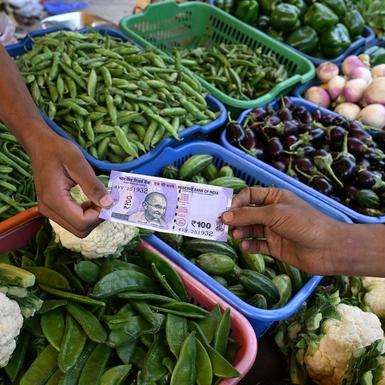NEW DELHI: Led by a decline in food prices and a high base effect, India’s consumer price index (CPI) -based retail inflation in March eased to 3.34 per cent, the lowest since August 2019, raising hopes of further repo rate cuts by the Reserve Bank of India (RBI).
Data released by the statistics ministry on Tuesday showed that the headline retail inflation figure nearly touched a six-year low in March, down from 3.61 per cent in February, remaining below the central bank’s medium-term target for a second consecutive month. In August 2019, the headline retail inflation figure had stood at 3.28 per cent.
Separately, data released by the Ministry of Commerce and Industry on Tuesday showed that India’s wholesale price index-based inflation also cooled to a six-month low of 2.05 per cent in March, down from 2.86 per cent in February, due to easing food prices, even as there was a sequential increase in the prices of manufactured products and fuel.
In retail inflation, data showed that food inflation fell sharply to 2.69 per cent in March from 3.75 per cent in February, as the prices of cereals (5.93 per cent), milk (2.56 per cent), and meat (0.32 per cent) decelerated during the month. Further, the prices of vegetables (minus 7.04 per cent), eggs (minus 3.16 per cent), and pulses (minus 2.73 per cent) remained in contraction during the month.
However, prices of oils and fats (17.07 per cent), fruit (16.27 per cent), and sugar (3.89 per cent) accelerated in March.
The top-five items showing the highest inflation in March included coconut oil (56.81 per cent), coconut (42.05 per cent), gold (34.09 per cent), silver (31.57 per cent), and grapes (25.55 per cent). In contrast, the key items with the lowest inflation in March were ginger (minus 38.11 per cent), tomato (minus 34.96 per cent), cauliflower (minus 25.99 per cent), cumin (minus 25.86 per cent), and garlic (minus 25.22 per cent).
Aditi Nayar, chief economist at Icra, said that further monetary easing was clearly on the table, to the tune of 50 basis points (bps) over the next three RBI monetary policy committee (MPC) meetings, as the next inflation print was also expected to be sub-4 per cent.
“A rise in temperatures ahead could raise the prices of perishables in the coming weeks. While the initial forecast of an above-normal monsoon is encouraging, the timing and distribution will be key for the implications for agricultural output and food inflation going forward,” she added.
Echoing similar views, Rajani Sinha, chief economist at CARE Ratings, said that the RBI’s rate-cut cycle being even deeper could not be ruled out if global trade uncertainties severely dented growth prospects, with a further 50-bp reduction in the policy rate expected in 2025-26 (FY26).
“The recent moderation in the dollar index and expectations of more US Federal rate cuts place the RBI in a better position to undertake further reductions in the policy rate,” she added.
Earlier this month, the six-member MPC had unanimously lowered the policy repo rate by another 25 bps to 6 per cent and also changed its policy stance to ‘accommodative’, signalling the likelihood of further easing in the coming months. It also lowered its CPI-based inflation projection for FY26 to 4 per cent from 4.2 per cent.
Addressing the customary post-policy review press conference, RBI Governor Sanjay Malhotra said that the outlook for food inflation had turned decisively positive, with the uncertainties regarding rabi crops abating considerably.
“A sharp decline in inflation expectations in our latest survey for three months and one year ahead would also help anchor inflation expectations going forward. The fall in crude oil prices, too, augurs well for the inflation outlook,” he added.
Core inflation, which excludes volatile food and fuel components, inched up slightly during the month but remained benign (around 4 per cent), as prices of housing (3.03 per cent) and services like health (4.26 per cent), transport (3.3 per cent), and personal care (13.5 per cent) accelerated during the month.
Meanwhile, commerce ministry data showed that in WPI, the manufactured products category, which has a weighting of 64.2 per cent in the index, saw inflation rising to 3.07 per cent in March from 2.86 per cent in February. This was led by acceleration in the prices of manufactured goods like paper products (2.39 per cent), leather products (2.02 per cent), apparel (1.98 per cent), and pharmaceuticals (1.26 per cent), among others.
Similarly, the prices of fuel and power also accelerated to 0.2 per cent in March from minus 0.71 per cent in February. This was due to deflation in the prices of petrol (minus 3.86 per cent) and high-speed diesel (minus 2.88 per cent) narrowing during the month.
Source: Business Standard


 Trade Deficit Widens To $21.54 Billion, Exports See 0.7% Growth In March
Trade Deficit Widens To $21.54 Billion, Exports See 0.7% Growth In March 